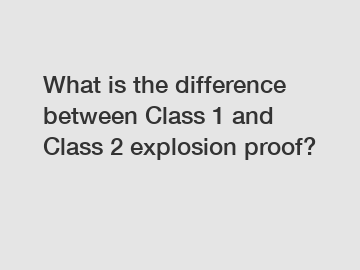Feb. 09, 2024
Lights & Lighting
With competitive price and timely delivery, MAM sincerely hope to be your supplier and partner.
What is the difference between Class 1 and Class 2 explosion proof?
Explosion-proof equipment is essential in industries where flammable gases, vapors, liquids, or combustible dusts are present. These hazardous environments require equipment that can prevent explosions and ensure the safety of workers and facilities. Class 1 and Class 2 explosion-proof classifications are two distinct classifications that define the level of protection provided by the equipment. Understanding the differences between these two classes is crucial in selecting the right equipment for specific hazardous environments.

Class 1 explosion-proof equipment is designed for locations where flammable gases or vapors are present in sufficient quantities to produce explosive or ignitable mixtures. This class is further divided into two divisions: Division 1 and Division 2. Division 1 refers to locations where explosive gases or vapors are present continuously, intermittently, or periodically under normal operating conditions. In these environments, the equipment must be designed and constructed to withstand and prevent the ignition of such gases or vapors.
On the other hand, Division 2 locations are areas where explosive gases or vapors are present only under abnormal conditions. In these areas, the equipment is not designed to prevent the ignition of these substances but must still be constructed in a way that eliminates any potential sparks or heat sources that could trigger an explosion.
Class 2 explosion-proof equipment, on the other hand, is specifically designed for locations where combustible dusts, rather than gases or vapors, are present. These combustible dusts, like finely divided metals, wood, or coal, can ignite and cause explosions if they come into contact with an ignition source. Similar to Class 1, Class 2 is also divided into two divisions: Division 1 and Division 2.
Division 1 refers to locations where combustible dust is present continuously, intermittently, or periodically under normal operating conditions. The equipment designed for these environments must be able to withstand and prevent the ignition of combustible dust. Division 2, on the other hand, includes locations where combustible dust may be present under abnormal conditions. In these areas, the equipment is not required to prevent the ignition of combustible dust, but must still be designed to eliminate potential sources of sparks or heat.
Understanding the differences between Class 1 and Class 2 explosion-proof classifications is essential for ensuring the correct selection and installation of explosion-proof equipment in hazardous environments. Failing to choose the appropriate equipment can lead to catastrophic consequences, including explosions, fires, and life-threatening injuries. Therefore, thorough risk assessments and understanding of the hazardous substances present in the environment are crucial in determining which class of explosion-proof equipment is required.
In conclusion, while both Class 1 and Class 2 explosion-proof classifications are vital for protecting against potential hazards, they differ in terms of the hazardous substances they address. Class 1 focuses on flammable gases and vapors, while Class 2 addresses combustible dust. By adhering to these classifications and choosing the appropriate explosion-proof equipment, industries can ensure a safe working environment and mitigate the risks associated with potential explosions or fires.
Click here to get more.
If you want to learn more, please visit our website explosion proof panel board.
Previous: The Power of 230W COB LED Chip: Unleashing Brilliance
Next: Unveiling the Philips DN350B: The Ultimate Solution for Enhanced Audio Experiences!
If you are interested in sending in a Guest Blogger Submission,welcome to write for us!
All Comments ( 0 )